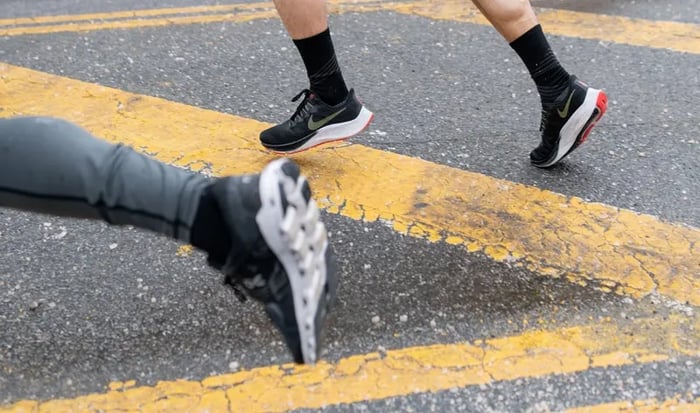Achilles Tendinopathy Deep Dive
February 21, 2021
 When we look around social media, we’re immediately bombarded with content such as “5 Best Stretches for Knee Pain” or “10 Minute Stretch to Get Rid of Lower Back Pain” or “Glute Warm Ups Before Running.” While some of this content can definitely be useful in some individual’s circumstances, as a physical therapist, I often find that people are skipping some important factors that are MORE LIKELY the cause of their issues.
When we look around social media, we’re immediately bombarded with content such as “5 Best Stretches for Knee Pain” or “10 Minute Stretch to Get Rid of Lower Back Pain” or “Glute Warm Ups Before Running.” While some of this content can definitely be useful in some individual’s circumstances, as a physical therapist, I often find that people are skipping some important factors that are MORE LIKELY the cause of their issues.
In this article, I’ll use Achilles Tendinopathy (Read: Activity-related soreness in the achilles/back of ankle) as a case study example for how multiple different mechanisms can create this dysfunction. I’ll touch on these factors from a more ecological perspective, and attempt to give a constructive thought process on how you can understand your body BETTER.
You haven’t matched your programming to your output capabilities
It’s important to know what your experience level and athletic ability will allow you to do. This determines your program, and how it properly suits you. Some common mistakes:
- Grading your experience level higher than it really is: Leads to program choices where volume, pace, and frequency are likely not matching the athlete’s needs. Be honest with your experience level. Volume leads to fatigue, and fatigue leads to a higher potential for sore Achilles.
- Running too fast, too often: Smart programming for longevity tells us that you should really only be in your higher intensity levels 20-40% of the time. If you’re running hard every time out, it’s likely you’ll break down. Keep in mind that your ankle functions as a spring in your gait, and the faster you try to run, the more load goes into that spring.
- You’ve never been an athlete before this: You may need to prepare your body physiologically. Non-athletes tend to struggle with Achilles tendon pain and other tendon-related issues because the connective tissues aren’t prepared for the repetitive load. Take up a plyometric program to get ready for sport.
Action: Choose a goal pace for your next 3 runs. If it was hard to maintain in at least 2 of 3, consider adjusting your paces.
You’re following someone else’s lead rather than going with your body’s signals
Don’t get me wrong; running with your buddies and having a community is great. That said, it’s important to take these things into consideration in the process.
- Not everyone there is running your pace
- Athletes will be training for different distance races, and the programs differ accordingly
- It’s hard to focus on your individual technique when conversing with others
- Running SLOWER than your own pace leads to high impact, and more likely sore Achilles
Action: Plan ahead for your next group run and match up with someone on a similar pace and distance. Stick to the plan, even when others are running faster.
Other workouts are making it difficult to execute a training program effectively
Cross training is great, and most of us need to do some strength training to supplement our running programs. Where athletes run into trouble is when they get interested in too many activities. Picture this, you’re training for a half marathon, and running 4-5 days a week for it (Let’s assume you’re on a program suited to you). Additionally, you go to HIIT class 2x/week, Spinning 2x/week, and play pickup basketball with your friends.
As interest in fitness has increased, it’s more and more common for people to add too many activities. With the schedule above, the athlete is training 11 sessions a week of lower-body load, leaving almost no opportunity for recovery here. When our most frequent activity is running, achilles pain is incredibly common if you’re mixing in too many other sports.
Keep in mind that while you may be executing all of these workouts properly, the body isn’t built to handle the cumulative load.
Technique is a factor
We like to keep it simple with technique advice over the internet. People with real issues should seek a professional analysys from a Physical Therapist who is experienced in assessing runners, as well as the rest of your body.
For now, consider this:
- Keep your legs and strike point underneath your hips. Reaching too far ahead can cause a braking effect on each stride, and a lot of load to the achilles if you are striking in the mid or forefoot.
- Make sure there is a gentle rotation of the upper body to match your stride (not exaggerated, but not stiff). Think 15-20 degrees of forward rotation of the chest, opposite of your striding leg. This will allow you to carry your momentum more effectively into the next stride, and minimize tendon stress.
Action: Take your next easy run as an opportunity to focus on your technique. Don’t apply new technique thoughts to long runs right away. New habits will take time to build reliability.
The ground is your worst enemy
Most of us are training on rock-hard surfaces all of the time. In NYC, our road runners are pounding pavement all the time, and it makes for an even higher level of importance of managing ground contact time. That means that as you begin to contact the ground, your body is already prepared to resist those loads upward into the joints. Athletes with appropriate elasticity, and plyometric capability will look like they are trampolining off of the ground into the next stride, whereas less experienced athletes tend to slap their foot into the ground, creating more load on the achilles to decelerate this increased load. Ground contact should have the following qualities: short, quiet, and forward-propelling. These thoughts allow us to prevent the ground from putting the brakes on every step, and compromising the efficiency of our runs.
Action: Mix in softer surfaces for recovery runs when you can.
Listening to your emotions instead of your physiology
Everyone knows a runner that is running FROM something, and another runner that is running TOWARDS something. It’s definitely okay to use running as a decompressing emotional release, but if you’re becoming dependent on that feeling, it may lead to poor choices in your training, or going off program. Achilles pain in runners is highly correlated with poor choices of intensity and volume.
Quiz yourself: In the last 3 months, how many times have you run too fast, too long, or trained when you weren’t supposed to? If the answer is more than 1, try to be reflective in your upcoming training runs, and talk to a friend about how you’re feeling. Chances are that people in your community are feeling stressed too, and you can help each other get comfortable with staying on-program.
Your s#!t really DOESN’T move properly
Check on these lesser-known areas that can compromise the Achilles tendon:
Sub-talar joint and ankle mobility: Plant your foot flat on the ground in a half-kneeling position. Attempt to rock side-to-side on the heel, encouraging the ankle to invert (cupping the foot) and evert (flattening the foot). Take note of how much it can move, and compare to the other side. A side effect of extreme stiffness here is a calf and achilles that works too hard to stabilize ground contact.
FFE (Front Foot Elevated) split-squat with calf raise: Initiate a split squat position by placing one foot flat in front of you, and the other kneeling just below your hips. Elevate the front foot by placing it on top of a firm surface or a yoga block (at least 3 inches). Press through the ground to hover the trailing knee just a few inches from the ground, and hold the position. When you’ve stabilized your balance, perform a calf raise on the front ankle, and hold the heel as elevated as possible for 30 seconds. Repeat on the other side. Difficulty in this drill demonstrates higher likelihood of difficulty transitioning weight though the forefoot.
Single-leg square plyometrics: Mark off a 1-foot box on the floor with tape. Standing on one leg, perform single-leg hops for 30 seconds. Take a video so you can observe your performance. Goal: To stay inside the box for the whole time, minimize the amount that the heel drops to the floor, minimize ground contact time, avoid pain. Repeat on the other side and compare symmetry. Difficulty with this drill may indicate central instability, pain on repeated loading, or lack of body awareness.
Quadruped pelvic drops: Get a yoga block and place it between your knees on the floor (lowest height). Elevate both knees, placing one knee onto the block. Keeping the rest of your body squared up, attempt to lower the opposite knee to touch the floor. It’s not easy to do this without shifting side-to-side or dipping the rest of the body to the floor. Repeat on the other side. Difficulty with this drill may expose a difficulty rotating through one side of your body in your running stride.
90-90 transitions (hands-free): Sit on the floor with one leg in front of you at a 90 degree angle (toes pointing forward), and the other leg to the side at a 90 degree angle (internally rotated, toes pointing to your side). Imagining the front leg stays glued to the floor as long as possible, transition to the same posture on the opposite side. Try not to use your hands for support, and observe any breakdown in posture. Repeat in the other direction and compare for symmetry. Difficulty with this drill is an overall indicator of limited hip mobility and control. Athletes with this predisposition are more likely to over-stress the ankles in their running.
New to running? Check out our TOTAL 10K Program. We’ve taken a unique approach to using distance, effort level, mobility and strength training to get you ready for your race.
Issues with your mobility drills? Check out our 90-day mobility program, or reach out to schedule a tele-health session with a Doctor of Physical Therapy at MOTIVNY.

LUKE GREENBERG
Manual Medicine, Kettlebells and Golf Training, Team Dad